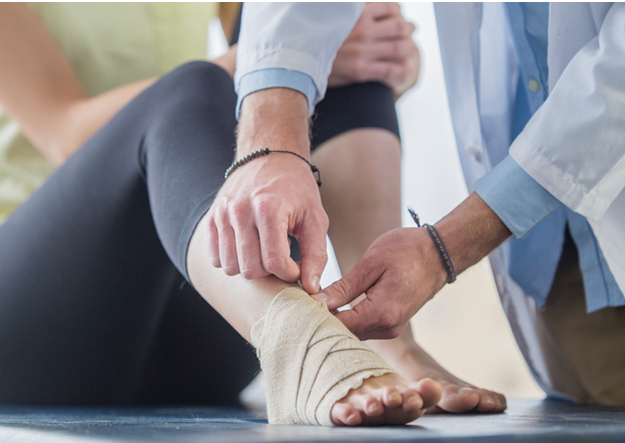Diagnosis and Treatment of Foot and Ankle Arthritis in Wake County

What is Foot and Ankle Arthritis?
Arthritis is the presence of inflammation in your joints. The word arthritis serves as an umbrella term for over 100 diseases. Since the foot and ankle are made up of many joints, arthritis in these areas can make it difficult for you to perform everyday tasks, such as walking. As arthritis progresses, the affected joint’s soft tissue structures and cartilage erode, causing bone-on-bone friction that can lead to pain, weakness, and loss of mobility.

Causes of Foot and Ankle Arthritis
Arthritis of the foot and ankle usually occurs due to wear and tear from aging, as the result of an injury, or due to an autoimmune disease. Types of arthritis that may affect the foot and ankle include:
- Osteoarthritis – arthritis that happens after years of wear and tear as the natural result of aging
- Post-traumatic arthritis – arthritis that occurs after an injury such as a dislocation or fracture
- Rheumatoid arthritis – an autoimmune disease that causes your immune system to attack your joints. This type of arthritis usually happens to the same joint on each side of your body.
Foot and Ankle Arthritis Risk Factors
Trauma or injury to the joint, a family history of osteoarthritis, obesity, and an underlying medical condition such as rheumatoid arthritis are all risk factors for developing arthritis in the foot and ankle.
Symptoms of Foot and Ankle Arthritis
Being aware of foot and ankle symptoms is key to getting the treatment and relief you need. Symptoms of foot and ankle arthritis to watch out for include:
- Inability to walk or pain with walking
- Swelling, warmth, or redness in the affected area
- Pain that gets worse with sitting or after sleeping
- Pain after sports or vigorous activity
- Pain during activities or movement of the affected area
- Stiffness of the affected joint
- Joint deformity (in extreme cases)
How are Foot and Ankle Arthritis Diagnosed?
Your doctor will collect your medical history, taking special note of your family history of arthritis and any past foot and ankle injuries you may have suffered. After learning more about your symptoms, including when they began and what makes them better or worse, your doctor will perform a gait analysis to determine the location and severity of your foot and ankle arthritis as you walk. Imaging tests such as weight-bearing X-rays to determine the health of your cartilage, CT scans to show a more detailed picture, or MRIs to show soft tissue damage may be performed. If your doctor suspects something like rheumatoid arthritis, they may recommend a blood test.

Treatment Options for Foot and Ankle Arthritis at Raleigh Orthopaedic
Foot and ankle arthritis has no cure, but your symptoms can be managed with both surgical and nonsurgical methods.
Conservative, nonsurgical treatment methods for foot and ankle arthritis include losing weight to reduce pressure on your feet and ankles, along with modifying your activities to avoid exacerbating the condition. If you are an avid runner, you may want to substitute some or all of your workouts with biking or swimming to reduce the pounding on your feet and ankles. Physical therapy to help strengthen your feet and ankles and increase your range of motion may also help manage the pain. If physical therapy worsens the pain, your doctor will advise you to stop. Anti-inflammatory drugs or cortisone injections are another nonsurgical option for pain relief. Braces for your ankles or inserts for your shoes to improve your gait may also help.
If nonsurgical treatments do not relieve your pain, your doctor may recommend surgery. One surgical option is arthroscopic debridement, during which the surgeon removes loose bodies (bone or cartilage) in the joint in order to alleviate your pain. If your pain is severe, your doctor may perform a surgery called arthrodesis, which fuses the affected joint in order to relieve symptoms. In extreme cases, you may elect to have a total ankle replacement, during which your doctor will replace the diseased joint with a metal or plastic implant.

Foot and Ankle Arthritis Recovery Time
Recovery from foot and ankle arthritis surgery can take anywhere from 4 to 9 months depending on the type of surgery you received. If you elect to use nonsurgical methods to alleviate your pain, you may see positive results during or after implementation. However, since there is no cure for arthritis, most of these methods will manage your pain rather than eliminate it entirely.
How Can I Prevent Foot and Ankle Arthritis?
You may not be able to prevent foot and ankle arthritis since it is often caused by simple wear and tear of the joints, past injuries, or rheumatoid arthritis. However, maintaining a healthy weight, eating a well-balanced diet, along with stretching and exercising regularly can help to keep your feet and ankles healthy. You should also consult your doctor if you experience an orthopedic foot or ankle injury so that care can be taken to prevent future arthritic changes

Expert Foot and Ankle Care and Treatment at Raleigh Orthopaedic
For over 100 years, we have served patients in Wake County and provided the highest level of orthopedic care. Whether you come to us with a sudden sports injury or chronic foot pain, we will take the time needed to understand your symptoms and formulate a personalized treatment plan for you. To start your journey with Raleigh Orthopaedic, please give us a call today or book an appointment online.




